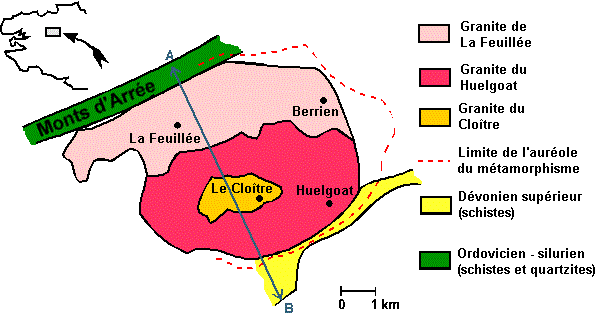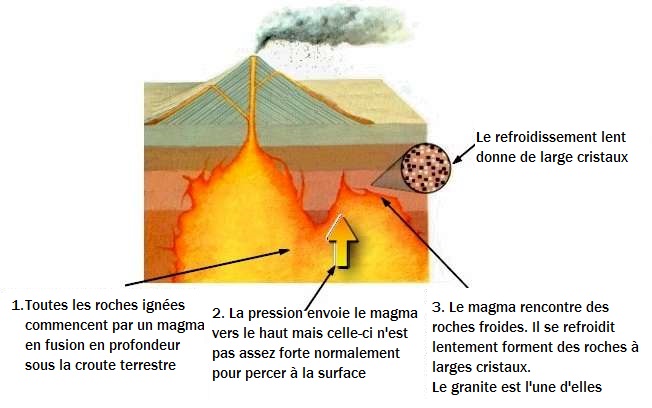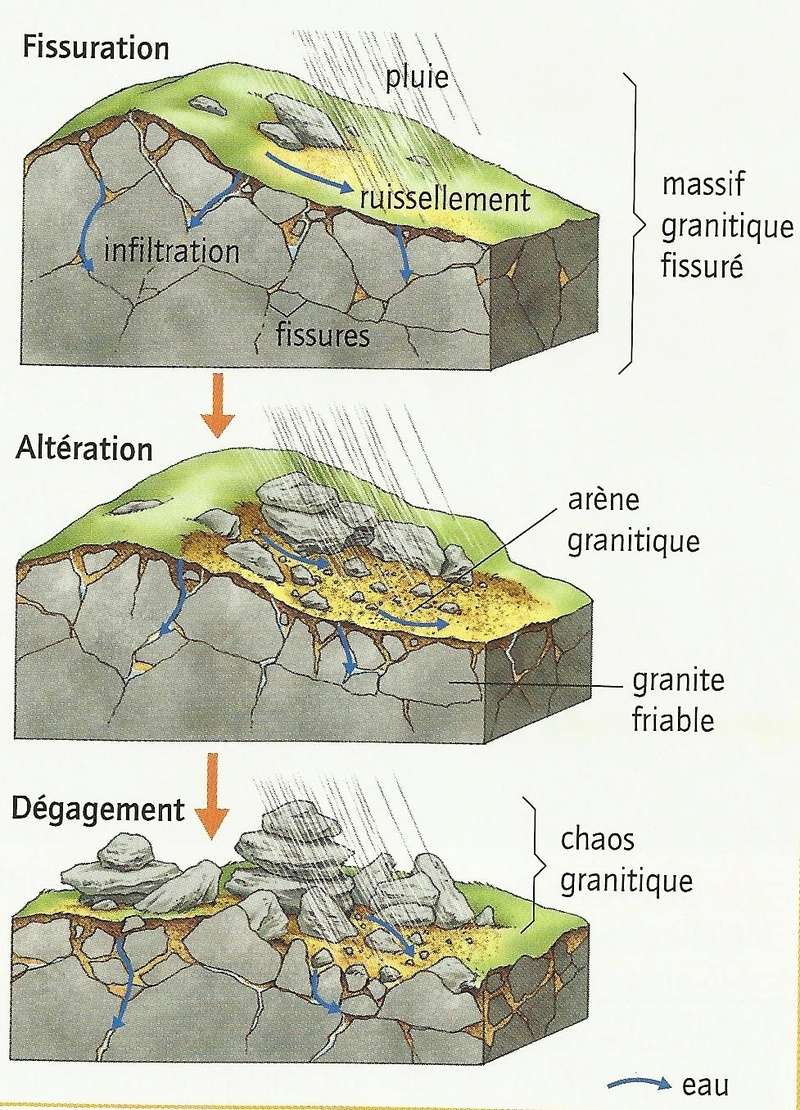Géologie intra muros - Brest #01
Le Granite de Huelgoat !!

La ville de Brest ayant, pour une bonne partie, été détruite durant la seconde guerre mondiale, la majorité des bâtiments est de construction récente.
C'est lors de la reconstruction de la ville que certains édifices ont été rebâtis avec des matériaux locaux.
Les édifices de la Mairie de Brest et de la Poste centrale sont notamment bâtis avec du granite de Huelgoat.

Le granite est une roche formée dans les grandes profondeurs de la Terre d'origine magmatique plutonique, à texture grenue. Sa composition chimique très acide est en majorité formée de silice et d 'alumine, Il contient aussi entre autre de l' uranium.
Les massifs de granite du Huelgoat ont une forme de bulle (pluton). Le magma formé à 7 ou 8 km de profondeur " injectés" pour des raisons tectoniques dans des formations sédimentaires dévoniennes (- 419,2 ± 2,8 à 358,9 ± 0,4 millions d’années) à 3 ou 4 km de profondeur et, encore chaud, il induit dans ces formations un métamorphisme de contact (schiste à cristaux millimétriques d'andalousite de kerphalite) lors de la formation de la chaîne varisque ou chaîne hercynienne qui se forme du Carbonifère au Permien( 358,9 ± 0,4 à 252,2 ± 0,5 millions d'années.).

L'érosion dégage les terrains qui recouvrent le massif qui s'est solidifié à 4 km de profondeur. Elle dénude ainsi le granite qui "se rapproche de la surface". La décompression qui en résulte provoque une détente puis une dilatation du massif qui se fracture. Les fentes (diaclases) permettent la circulation de l'eau d'où hydrolyse et arénisation. Cette altération date du tertiaire (Miocène, Pliocène) sous un climat tropical humide.

La composition exacte du granite influe sur sa couleur. On dénombre plus de 500 couleurs différentes de granite.
Celui de Huelgoat a une teinte particulière, tout comme celui du Trégor, dont la teinte a fait la renommée de la côte.
Pour valider cette earthcache, il vous faudra vous rendre aux coordonnées indiquées et trouver les réponses aux questions suivantes.
- 1/ Comment se nomme les affleurements granitique présents à Huelgoat ?
- 2/ Comment se nomme la forme des massifs granitiques de Huelgoat ?
- 3/ En comparant avec les pierres de l'édifice que vous avez devant vous, désignez la photo qui correspond au granite de Huelgoat utilisé ici.

Des photos de vous devant le spot seraient fortement appréciées.
"Loguez cette cache "Found it" et envoyez-nous vos propositions de réponses soit via notre profil, soit via la messagerie geocaching.com (Message Center), et nous vous contacterons en cas de problème."
Nous ne désirons pas de FTF sur cette earthcache, car il n'y a pas de logbook prouvant la primeur du passage.

As the city of Brest was largely destroyed during the Second World War, the majority of buildings are of recent construction.
It was during the reconstruction of the city that some buildings were rebuilt with local materials.
The buildings of the Town Hall of Brest and the Central Post Office are built with granite from Huelgoat.

The granite is a rock formed in the great depths of the Earth of plutonic magmatic origin, with a grainy texture. Its highly acidic chemical composition is mainly composed of silica and alumina. It also contains uranium.
The granite massifs of Huelgoat have a bubble form (pluton). The magma formed at 7 or 8 km depth "injected" for tectonic reasons in Devonian sedimentary formations (- 419.2 ± 2.8 to 358.9 ± 0.4 million years) at 3 or 4 km Depth and still hot, induces a contact metamorphism (millimeter crystal shale of kerphalite andalusite) in these formations during the formation of the Variscan chain or Hercynian chain which forms from the Permian Carboniferous (358.9 ± 0 , 4 to 252.2 +/- 0.5 million years).

The erosion clears the ground that covers the massif which solidified to 4 km of depth. It thus denudes the granite which "approaches the surface". The resulting decompression causes a relaxation then a dilatation of the massif which breaks. The slits (diaclases) allow the circulation of the water from which hydrolysis and arenization. This alteration dates from the tertiary (Miocene, Pliocene) under a tropical humid climate.

The exact composition of the granite affects its color. There are over 500 different colors of granite.
That of Huelgoat has a peculiar hue, as is that of the Tregor, whose color has made the fame of the coast.
To validate this earthcache, you will have to go to the coordinates indicated and find answers to the following questions:
- 1 / What are the granite outcrops present in Huelgoat?
- 2 / What is the shape of the granite massifs of Huelgoat?
- 3 / When comparing with the stones of the building you have in front of you, designate the photo that corresponds to the granite of Huelgoat used here.

Pictures of you in front of the spot would be highly appreciated.
"Log in this" Found it "cache and send us your responses either via our profile or via the geocaching.com message center, and we'll contact you if there is a problem."
We do not want FTF on this earthcache, because there is no logbook proving the beginning of the passage.